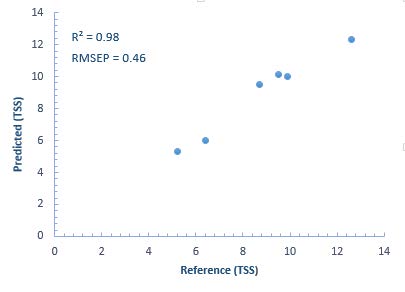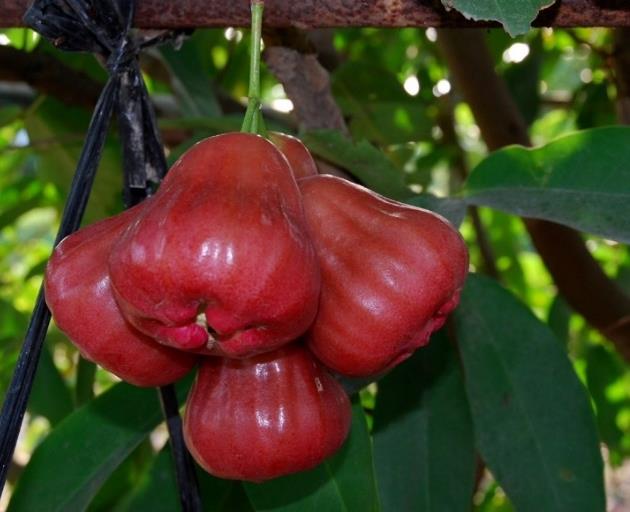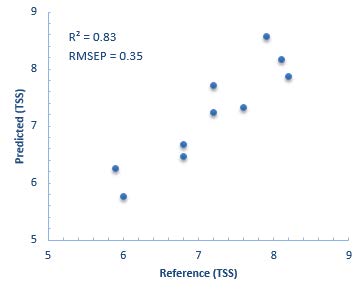August 24, 2016 at 10:50 pm | Updated August 24, 2016 at 10:50 pm | 4 min read
Non-destructive Measurements of Total Soluble Solids in Wax Jambu or Wax Apple (Syzygium samarangense)
Sugar (Total Soluble Solids (TSS) or ºBrix) content is regularly measured in wax apple or jambu throughout development and storage. Using traditional methodology, TSS measurements are destructive and time consuming. To determine effectiveness and viability of the F-750 Produce Quality Meter for non-destructive measurements of TSS in wax apple, a modeling study was conducted on 54 red wax apples. Destructive reference values were correlated with the non-destructive spectral data collected with the F-750 using the F-750 Model Builder Software, and results show that the F-750 Produce Quality Meter precisely and non-destructively measures TSS in wax apple, with a calculated root mean square error of prediction (RMSEP) of 0.46 TSS and a model prediction R2 of 0.98 for TSS.
Materials and Methods:
Subscribe to the Felix instruments Weekly article series.
By submitting this form, you are consenting to receive marketing emails from: . You can revoke your consent to receive emails at any time by using the SafeUnsubscribe® link, found at the bottom of every email. Emails are serviced by Constant Contact
In January 2016, 54 red wax apples were used to create a new model for the F-750 Produce Quality Meter. Using the screws on the lens housing as alignment markers, wax apples were consistently presented and scanned on the F-750 Produce Quality Meter at room temperature (20°C). Next, the same wax apple regions scanned with the F-750 were destructively measured for Total Soluble Solids (TSS) using the method described in Felix Instruments Mango Standard Operating Procedure (SOP). The spectral range of 729-975 nm was used by the F-750 Model Builder Software to detect correlations between the F-750 spectral signal and corresponding TSS values. The resulting regression data was analyzed for linearity, root mean square error, and leave-one-out cross validation error to determine the applicability and accuracy of the created model. A second population of 6 red wax apples were measured with the F-750 and used to independently validate the wax apple model. (Figure 2.)

Figure 1. Red wax apple variety (Syzygium samarangense).
Results and Discussion:
Results show that the F-750 Produce Quality Meter precisely, simultaneously, and nondestructively measures the TSS of wax apple. A strong correlation between spectral data and collected reference values is illustrated by a model prediction R2 of 0.98 for TSS. Figure 2 displays this correlation and demonstrates the consistency of measurement.
A calculated Root Mean Square Error of Prediction (RMSEP) of 0.46 TSS further illustrates the accuracy of the created model. This RMSEP value indicates the average uncertainty for a given measurement when the model is loaded onto the F-750 and used to predict TSS. The RMSEP is equivalent to the expected uncertainty within 68% of all predictions.

Figure 2. F-750 prediction value against reference method value of Total Soluble Solids in red wax apple.
Similar results were found with the F-750 and pink wax apples. A separate model made in January 2016 using 48 pink wax apples resulted in a model prediction R2 of 0.79 for TSS. A second population of 10 pink wax apples were measured with the F-750 to independently validate the wax apple model. Figure 3 displays this correlation with a calculated Root Mean Square Error of Prediction (RMSEP) of 0.35 and a model prediction R2 of 0.83 for TSS.


Figure 3. Left: Pink wax apple variety (Syzygium samarangense). Right: F-750 prediction value against reference method value of Total Soluble Solids in pink wax apple.
Conclusions:
The F-750 Produce Quality Meter accurately predicted Total Soluble Solids (TSS) in wax apple. Other tests and research findings have demonstrated the ability to measure other important internal fruit metrics with NIR technology. Similar results are expected for the
F-750 Produce Quality Meter with other wax apple varieties and traits. Acknowledgment and appreciation goes to Dr. Yu-Shen Liang, Assistant Professor at the National Pingtung University of Science and Technology in Taiwan for carrying out much of this work and sharing results to create this application note, and to Mr. Pond, KoHsieh Instruments Co. Ltd., Taiwan in the supportive role of mediating this application note and supporting scientific research.
Further Reading and Supporting Science:
Chuang, Y. K., Chen, S., Lo, Y. M., Tsai, C. Y., Yang, I., Chen, Y. L. & Chen, C. C. (2012). Integration of Independent Component Analysis with Near Infrared Spectroscopy for Rapid Quantification of Sugar Content in Wax Jambu (Syzygium samarangense Merrill & Perry). Journal of Food & Drug Analysis, 20(4).
Viegas, T. R., Mata, A. L., Duarte, M. M., & Lima, K. M. (2016). Determination of quality attributes in wax jambu fruit using NIRS and PLS. Food chemistry, 190, 1-4.
Related Products
- F-901 AccuRipe & AccuStore
- F-751 Melon Quality Meter
- F-751 Kiwifruit Quality Meter
- F-750 Produce Quality Meter
- F-751 Avocado Quality Meter
- F-751 Mango Quality Meter
- F-900 Portable Ethylene Analyzer
- F-950 Three Gas Analyzer
- F-920 Check It! Gas Analyzer
- F-960 Ripen It! Gas Analyzer
- F-940 Store It! Gas Analyzer
Most Popular Articles
- Spectrophotometry in 2023
- The Importance of Food Quality Testing
- NIR Applications in Agriculture – Everything…
- The 5 Most Important Parameters in Produce Quality Control
- Melon Fruit: Quality, Production & Physiology
- Ethylene (C2H4) – Ripening, Crops & Agriculture
- Liquid Spectrophotometry & Food Industry Applications
- Active Packaging: What it is and why it’s important
- Guide to Fresh Fruit Quality Control
- Understanding Chemometrics for NIR Spectroscopy
